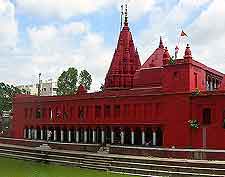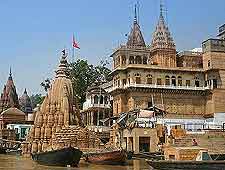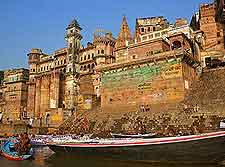Varanasi History Facts and Timeline
(Varanasi, Uttar Pradesh, India)

India's oldest city is also one of world's earliest centres of civilisation. The history of Varanasi stretches back several thousand years, with a vital role at the heart of Indian religion and spirituality throughout the entire era.
Buddhists, Hindus and also Jains all consider Varanasi and the Ganges River along which it sits to be the holiest place in all of India, if not the world. The 'City of Temples' remains to this day the most important spiritual site in the country.
A Home for Shiva
Legend has it that Varanasi's history began when the Hindu god Shiva founded the city along the holy Ganges many millennia ago. It has always held a special place in the mythology, poetry, history and religion of Indian civilisation, and is one of the seven sacred cities in the Hindu belief system.
An Ancient City
There's no doubting the antiquity of Varanasi. It appears in the ancient literature and Hindu scriptures, such as the Ramayana, Rigveda and Mahabharata. Most historians attest that the city is several thousand years old, making it one of the oldest continually inhabited cities on the planet. Besides its spiritual role, Varanasi has a history rooted in art, crafts and industry.
Kashi Kingdom
In its heyday, Varanasi was the capital of the wealthy Kashi Kingdom, famous throughout the known world for its silk, muslin cotton, sculptures and fragrances. During this era, around 550 BC, Gautama Buddha spent time here before giving his first sermon just 10 km / 6 miles away in the neighbouring town of Sarnath.
The Kashi era established Varanasi as a centre for culture, art, thinking and religion. It drew intellectuals, artists and soul searchers from across the Asian and European continents, searching for inspiration and like-minded discourse. This tradition endured for centuries after the Kashi. When the famous Chinese explorer Hsuan Tsang visited the city in 635 AD, it was still a hotbed of innovative thinking and spirituality that ran for some 5 km / 3 miles along the Ganges River.

Muslim Rule
Things began to unravel in Varanasi from 1194 onwards, when the city fell under Muslim rule for the next three centuries. Scholars were forced out, the great temples were destroyed and most Hindu traditions were suppressed. In the 16th century, a more enlightened and tolerant emperor, Akbar, ascended to the ruling Mughal throne. For a brief period he allowed the spiritual fire to rekindle in Varanasi. That was snuffed out a century later when Aurangzeb, a tyrannical Mughal king, came into power.

Regaining the Glory
The British Empire helped Varanasi regain its prestige in the Indian realm during the 18th century. When the British began carving up the country into states in 1910, Varanasi was established as both a city-state and a part of an independent kingdom, with its capital based in Ramnagar. At the time India gained independence from the British in 1947, the city merged with its new state of Uttar Pradesh.
Today, the city has returned to its ancient role as the religious centre of India, where pilgrims come to bathe in the holy Ganges River and explore the ghats and temples that line the riverside. However, like most religious issues, Varanasi remains a target for extremists in India. Most recently, in 2006, a terrorist bombing by Muslim extremists killed some 28 people at a Hindu temple.
 India's oldest city is also one of world's earliest centres of civilisation. The history of Varanasi stretches back several thousand years, with a vital role at the heart of Indian religion and spirituality throughout the entire era.
India's oldest city is also one of world's earliest centres of civilisation. The history of Varanasi stretches back several thousand years, with a vital role at the heart of Indian religion and spirituality throughout the entire era.
